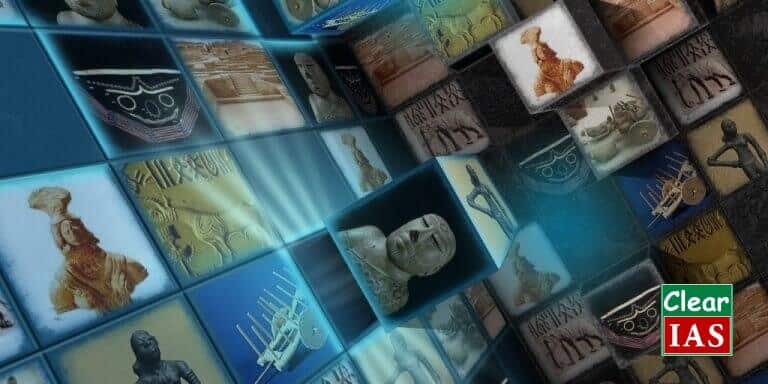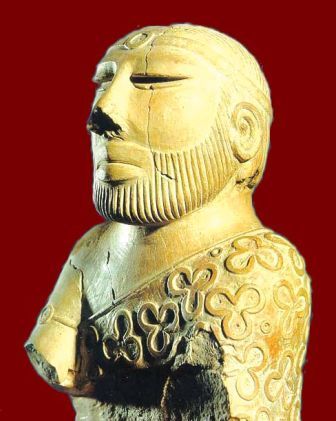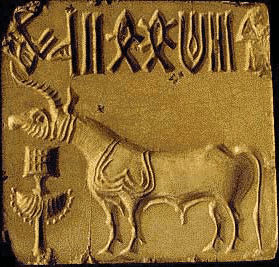The Priest King and Male Torso Reveal That Early Indus Valley Art Is
In this postal service, let's encounter the features of Indus Valley Civilisation arts as part of the Indian Civilisation notes based on the NCERT text 'An Introduction to Indian Art' – Part one. A detailed note well-nigh the features, sites, lodge, religion etc. of Indus Valley Civilization is already published in this website. As we have covered the prehistoric arts of India in the last article, we shall move to the adjacent major era in the cultural history of Bharat, ie. arts of Indus Valley.
Accept the ClearIAS UPSC prelims mock test on Indian culture. Yous non only volition learn the important facts related to Indian civilization, merely volition besides commencement to love the subject!
Arts of Indus Valley Civilisation

- The arts of Indus Valley culture, one of the primeval civilisations of the world, emerged during the 2nd half of the third millennium (Bronze Age).
- The forms of art plant from various sites of culture include sculptures, seals, pottery, gold ornaments, terracotta figures, etc.
- Their delineation of human and beast figures was highly realistic in nature.
- Modelling of figures was done in an extremely careful manner.
- Two major sites of Indus Valley civilization, along the river Indus are: North – cities of Harappa;South – Mohenjo-Daro.
- The site showcase one of the earliest examples of borough planning.
- Houses, markets, storage facilities, offices, etc. arranged in a grid-similar pattern.
- In this pattern, roads were cut beyond ane some other in 90-degree angle and the city was divided into blocks.
- In that location was too a highly adult drainage system.
- While Harappa and Mohenjo-Daro are situated in Islamic republic of pakistan, the important sites excavated in India are:
- Lothal, Surkotada, Dholavira – Gujarat
- Rakhigarh and Banwali – Haryana
- Ropar – Punjab
- Kalibangan and Balatha – Rajasthan
Materials used: Rock, Bronze, Terracotta, Clay etc.
The arts of Indus valley which are excavated even so are:
Stone Statues:
- Stone statues found in Indus valley sites are excellent examples of handling the 3D volume.
- Two major stone statues are:
- Bearded Man (Priest Human being, Priest-King)

UPSC Prelims cum Mains one-Year Online Program
Starts @ Rs.49000.
Bring together At present
- Found in Mohenjo-Daro.
- Bearded man's figure made ofSteatite.
- The figure interpreted as a priest and is draped in a shawl coming under the right arm and covering the left shoulder.
- The shawl is decorated with trefoil pattern.
- The eyes are elongated and half closed as in a meditative concentration.
- Nose is well formed and medium size.
- Short cut moustache and a short beard and whiskers.
- Hair is parted in the center and a plain woven fillet is passed round the caput.
- An armlet on the right hand and holes around cervix advise necklace.
- A slight bear upon of the Greek style of statues can be seen overall.
- Male Body
- Found in Harappa (merely major art element plant in Harappa).
- Made of Red Sandstone.
- There are socket holes in the cervix and shoulders for the attachment of head and arms.
- Legs are broken.
- The shoulders are well broiled and the abdomen slightly prominent.
- Ane of the well carved and finished work.
Statuary Casting:
- Bronze casting was practiced in wide scale in almost all major sites of the civilisation.
- The technique used for Statuary Casting was Lost Wax Technique.
[Initially, the figure needed is fabricated of wax and covered it with clay. Subsequently allowed to dry the clay, the whole thing is heated and then that the wax inside the clay will be melted. The molten wax was then tuckered out through a tiny hole made in the clay role. The hollow mold of clay thus created was filled with molten metal. Once information technology cooled, the clay cover was completely removed].
- Human as well as animal figures are present in the Bronze casting.
- Amongst beast figures the buffalo with its uplifted head, back and sweeping horns and the caprine animal are artistic claim.
- Copper domestic dog and bird of Lothal and the Statuary figure of a balderdash from Kalibangan shows that Bronze casting was popular at all centers of Indus valley civilization.
- Metal casting continued even after the Indus valley civilization through belatedly Harappan, Chalcolithic people, etc.
- Examples of Bronze casting are:
- Dancing Girl
- Institute from Mohenjo-Daro.
- Made upwards of Bronze.
- I of the best-known artifacts from Indus valley.
- Approximately iv-inch high figure of a dancing girl.
- This exquisite casting depicts a girl whose long pilus is tied in the bun and bangles cover her left arm.
- Cowry shell necklace is seen effectually her neck.
- Her correct mitt is on her hip and her left mitt is clasped in a traditional Indian dance gesture.
- She has large eyes and flat nose.
- Balderdash from Mohenjo-Daro
- Bronze figure of the balderdash found in Mohenjo-Daro.
- The massiveness of the bull and the fury of the accuse are eloquently expressed.
- The creature is shown continuing with his caput turned to the right.
- There is a cord around the cervix.
Terra cotta:
- Terra cotta figures are more realistic in Gujarat sites and Kalibangan.
- In terracotta, we find a few figurines of bearded males with coiled hairs, their posture rigidly upright, legs slightly apart, and the arms parallel to the sides of the body. The repetition of this figure in exactly the aforementioned position would suggest that he was a deity.
- A terracotta mask of a horned deity has also been establish.
- Toy carts with wheels, whistles, rattles, bird and animals, gamesmen, and discs were besides rendered in terracotta.
- The virtually important terracotta figures are those represent Mother Goddess.
- Mother Goddess
- Mainly found in Mohenjo-Daro.
- These figures are unremarkably rough standing figures.
- Adorned with necklaces hanging over the prominent chest and wearing a loin textile and a grid.
- The fan-shaped headdress with a cup like projection on each side is a distinct decorative feature of the mother goddess.
- The pellet eyes and beaked olfactory organ of the figure are very crude (constructed in a rudimentary way).
- Oral cavity is indicated by a narrow opening.
Seals:

- Thousands of seals were discovered from the sites, commonly made of steatite, and occasionally of agate, chert, copper, faience and terra cotta, with beautiful figures of animals such as unicorn bull, rhino, tiger, elephant, bison, caprine animal, buffalo, etc.
- The purpose was mainly commercial.
- They were also used every bit amulets, carried on the persons of their owners, maybe as mod identity cards.
- Standard Harappan seal was 2 x 2 foursquare inches.
- Every seal is engraved in a pictographic script which is yet to be deciphered.
- Some seals were as well been found in Gilt and Ivory.
- Seals of Pashupati Mahadeva
- Found in Mohenjo-Daro.
- The seal depicts a human figure seated cantankerous legged.
- An elephant and a tiger are depicted to the right side of the figure, while on the left a rhinoceros and a buffalo are seen.
- Two antelopes (deer) are shown below the seat (nearby his feet).
- The figure has a three horned head.
Pottery:
- Indus valley pottery consists of very fine wheel made wares, very few being handmade.
- Apparently pottery is more common than painted ware.
- Plain pottery is by and large red clay, with or without a fine red or grey slip.
- The blackness painted ware has a fine coating of red slip on which geometric and animal designs are executed in glossy black paint.
- Painted Earthen Jar
- Found in Mohenjo-Daro.
- Made on a potters' wheel with clay.
- The shape was manipulated past pressure level of the crafty fingers of the potter.
- Subsequently blistering a dirt model, it was painted with blackness color.
- High polishing was done as a finishing touch.
- Motifs are vegetal and geometric forms.
- Designs are simple.
Chaplet, Ornaments and Cosmetics:
- The Harappan men and women decorated themselves with a big variety of ornaments produced from every conceivable materials ranging from precious metals and gemstones to bone and baked clay.
- White necklaces, fillets, armlets and finger rings were commonly worn by both sexes.
- Jewellery constitute at Mohenjo-Daro and Lothal include necklaces of golden and semiprecious metal stones, copper bracelets and beads, gold earrings and head ornaments.
- A cemetery has been found at Farmona in Harappa where expressionless bodies were buried with ornaments.
- Well developed bead industries were present at Chauhudaro and Lothal.
- Some beads were fabricated of two or more stones cemented together.
- Also made models of animals, specially monkeys and squirrels, used as pivot head and beads.
- Spinning of cotton and wool was very common (both rich and poor practiced spinning).
- Men and women wore ii separate pieces of attire like to dhoti and shawl.
- Shawl covered the left shoulder passing below right arm.
- They were witting of fashion.
- Dissimilar hair styles were in vogue and beard was popular.
- Cinnabar was used as a corrective and face-paint, lipstick and collyrium (eyeliner) were as well known to them.
Compiled by Jijo Sudashan
Reader Interactions
veachuntoonesch1968.blogspot.com
Source: https://www.clearias.com/arts-indus-valley-civilization/

0 Response to "The Priest King and Male Torso Reveal That Early Indus Valley Art Is"
Post a Comment